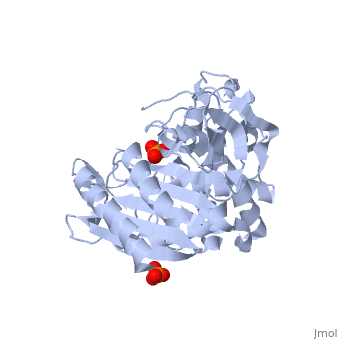Class C beta-lactamase
From Proteopedia
(Difference between revisions)
| (3 intermediate revisions not shown.) | |||
| Line 1: | Line 1: | ||
Beta-lactamases are awesome | Beta-lactamases are awesome | ||
| - | <Structure load='1ke4' size=' | + | <Structure load='1ke4' size='350' frame='true' color='white' align='right' caption='E. coli AmpC Class C Beta-lactamase complex with phosphate (PDB code [[1ke4]])' /> |
== Background and beta-lactam antibiotics == | == Background and beta-lactam antibiotics == | ||
| - | <StructureSection load='1stp' size='340' side='right' caption='Caption for this structure' scene=''> | ||
| - | Since the discovery of penicillin in the late 1920s, β-lactam antibiotics, characterized by their central chemical structure, the β-lactam ring, have played an important role in human health (Fig 1). Unfortunately, extensive use, and often misuse, of such drugs has led to an increased resistance in many species of bacterium resulting in major clinical treatment dilemmas. Each year in the United States alone, a minimum of 2 million people are infected with drug-resistant bacteria and of those 2 million, at least 23,000 infections result in fatality. | ||
| - | [[Image:Beta-lactam.jpg]] | ||
| - | + | Since the discovery of penicillin in the late 1920s, β-lactam antibiotics, characterized by their central chemical structure, the β-lactam ring, have played an important role in human health (Fig 1). Unfortunately, extensive use, and often misuse, of such drugs has led to an increased resistance in many species of bacterium resulting in major clinical treatment dilemmas. Each year in the United States alone, a minimum of 2 million people are infected with drug-resistant bacteria and of those 2 million, at least 23,000 infections result in fatality.<ref>Antibiotic Resistant Threat Report in the United States, 2013. Centers for Disease Control and Prevention. 16 September, 2013. | |
| - | + | ||
| - | + | ||
Current revision
Beta-lactamases are awesome
|
Background and beta-lactam antibiotics
Since the discovery of penicillin in the late 1920s, β-lactam antibiotics, characterized by their central chemical structure, the β-lactam ring, have played an important role in human health (Fig 1). Unfortunately, extensive use, and often misuse, of such drugs has led to an increased resistance in many species of bacterium resulting in major clinical treatment dilemmas. Each year in the United States alone, a minimum of 2 million people are infected with drug-resistant bacteria and of those 2 million, at least 23,000 infections result in fatality.[1]

